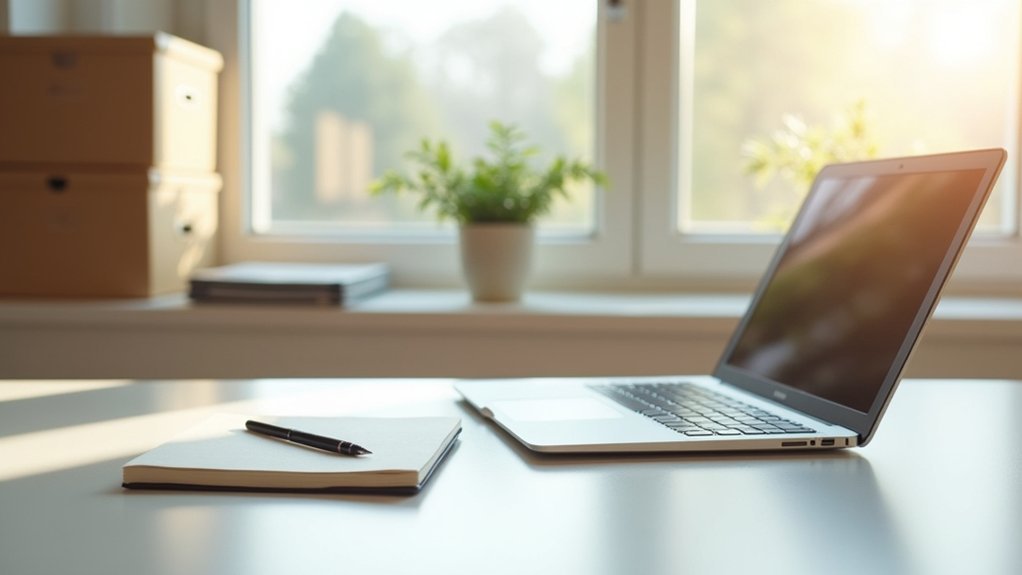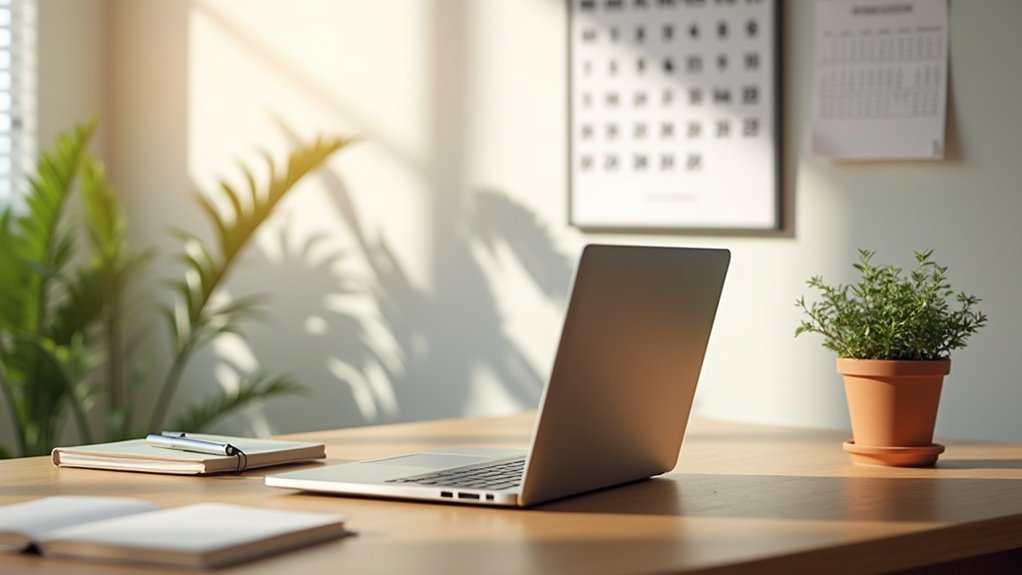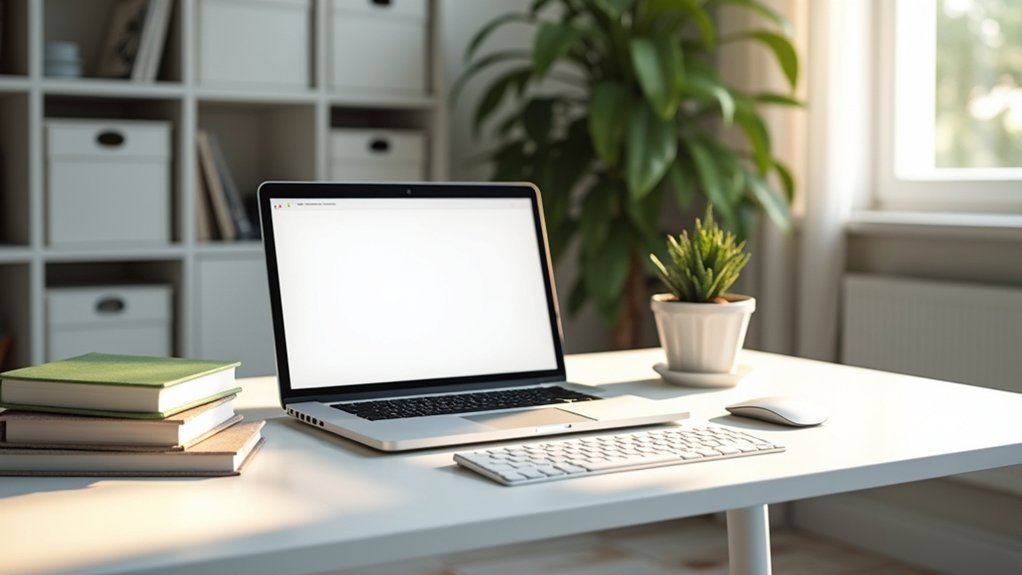Your workspace looks like a tornado hit a paper factory, scattering chaos across every surface. Clutter isn’t just a visual nuisance; it’s a productivity killer that traps your potential behind mountains of disorganization. If you’ve ever felt overwhelmed by the mere sight of your desk, you’re not alone. Procrastination thrives in messy environments, whispering distractions and stealing your focus. But what if a simple decluttering strategy could transform your workspace from a stress zone into a productivity powerhouse? Stick around, and you’ll discover how.
Key Takeaways
- Break overwhelming tasks into smaller, manageable steps to reduce mental barriers and minimize procrastination triggers in your workspace.
- Dedicate 10 minutes daily to systematic decluttering, creating a clear physical environment that promotes mental focus and productivity.
- Implement the 2-minute rule for immediate organization, tackling quick tidying tasks to build momentum and reduce workspace chaos.
- Utilize digital and physical organizational tools like magnetic monitor arms, cable management systems, and systematic folder structures to optimize workspace efficiency.
- Create accountability by sharing decluttering goals with a partner or joining community support groups to maintain consistent workspace organization.
Understanding Procrastination and Clutter

While clutter may seem like a minor inconvenience, it’s a significant catalyst for procrastination that can derail your productivity and mental clarity. Mental clutter creates invisible barriers that make tasks feel overwhelming, causing you to delay important work. When your workspace is disorganized, your brain struggles to focus, effectively transforming physical chaos into mental paralysis.
Understanding your unique procrastination patterns related to clutter is essential. Emotional attachments to items and the seemingly intimidating prospect of organizing can trigger avoidance behaviors. By recognizing how disorganization generates stress and reduces efficiency, you’ll be better equipped to tackle procrastination. An organized environment isn’t just about tidiness—it’s about creating mental space that allows you to approach tasks systematically and confidently, ultimately enhancing your productivity and reducing unnecessary mental strain.
The Psychological Impact of a Disorganized Workspace

Although seemingly innocuous, a disorganized workspace can profoundly impact your psychological well-being and professional performance. Clutter makes you feel less productive and more stressed, hindering your ability to overcome procrastination and work better.
| Emotional Impact | Productivity Loss | Stress Level |
|---|---|---|
| Overwhelm | 2.5 hrs/week wasted | High anxiety |
| Decreased focus | Reduced efficiency | Mental chaos |
| Creative block | Task management | Emotional drain |
| Mental fatigue | Performance decline | Psychological burden |
Research confirms that when you can’t easily find things, your mental clarity suffers. Developing better habits of organization isn’t just about tidiness—it’s a strategic approach to managing your psychological landscape. A clean workspace transforms your environment from a source of stress to a catalyst for clarity, enabling you to focus more effectively and reduce the mental burden that accompanies disorganization.
Strategies to Break Down Overwhelming Tasks

Because overwhelming tasks can paralyze even the most motivated professionals, developing a systematic approach to task management becomes essential for maintaining productivity. When you break tasks into smaller, more manageable tasks, you’ll transform intimidating projects into achievable goals. Start by identifying the first step and using a timer to create urgency. The Pomodoro Technique can help you stay focused during 25-minute work intervals, making decluttering feel less intimidating. Take time to establish clear objectives, like focusing on one object at a time, which builds momentum and confidence. Regularly review your approach, identifying patterns that hinder progress. These tips to declutter your workflow will help you overcome procrastination, turning overwhelming challenges into systematic, actionable steps that drive meaningful progress.
Creating Accountability and Urgency

How can you transform decluttering from a solitary struggle into a dynamic, goal-driven process? By creating accountability and a sense of urgency, you’ll declutter your workspace more effectively. Start by sharing your goals with an accountability partner who’ll track your progress and provide motivation. Use calendars to set “drop dead dates” for specific decluttering tasks, which helps you maintain focus and complete projects systematically.
Consider hosting decluttering events with friends or joining community groups focused on organization. These social approaches not only provide external accountability but also make the process more engaging. By introducing time-bound commitments and collaborative support, you’ll naturally reduce procrastination and transform your workspace more efficiently. The key is turning individual effort into a structured, motivating experience.
Leveraging Technology for Workspace Organization

Technology offers powerful solutions for workspace organization, extending the accountability strategies we’ve explored. By leveraging digital tools, you can transform your workspace into an efficient environment that minimizes distractions and maximizes productivity. Implement magnetic monitor arms to optimize screen placement, reducing physical clutter while creating a streamlined work setup. Utilize cable management systems with magnetic anchors to eliminate tangled wires that consume valuable time and mental energy.
Digital organization techniques are vital for managing workspace efficiency. Create a systematic folder structure, set regular file clean-up reminders, and use technology to track important tasks. A magnetic headphone hanger and strategic cable management can help you declutter and organize your physical and digital workspace, ultimately reclaiming time and focus for meaningful work.
Practical Cable and Peripheral Management
When managing workspace cables and peripherals, systematic organization isn’t just about aesthetics—it’s a critical strategy for maintaining productivity and mental clarity. By leveraging magnetic anchors, you can transform cable clutter into a streamlined workspace environment. The Secretlab Cable Management Bundle allows you to prevent tangled wires and create an efficient workflow. Strategic placement of magnetic headphone hangers and monitor arms can optimize your desk space, ensuring peripherals are both accessible and neatly arranged.
Mounting multiple monitors at eye level using risers reduces physical strain while creating additional storage zones. Organizing cables with precision minimizes visual distractions and supports cognitive focus. Each strategic placement contributes to a workspace that’s not just organized, but engineered for peak performance and minimal interruption.
Maximizing Desk Space and Efficiency
While effective workspace organization demands strategic thinking, maximizing desk space requires a methodical approach to peripheral placement and workflow optimization. You’ll find that leveraging tools like Secretlab MAGNUS Monitor Arms can dramatically reduce physical clutter, allowing you to mount multiple screens and free up valuable workspace. By implementing smart solutions such as the MAGNUS Desk Riser, you’ll elevate your monitors to ergonomic eye levels while creating additional storage for peripherals.
Keeping things organized means less time spent searching and more time working efficiently. Strategic cable management with solutions like the Secretlab Cable Management Bundle guarantees your desk remains clean and focused. Remember, a well-structured workspace isn’t just about appearance—it’s about creating an environment that enhances productivity and minimizes distractions.
Developing Sustainable Organizational Habits
Beyond optimizing physical workspace layout, sustaining an organized environment demands consistent, intentional habits. Your daily decluttering routine doesn’t need to be complex; start with small steps like a 10-minute organization session. Use the two-minute rule to handle immediate tasks, preventing clutter accumulation. Implement strategic storage solutions with labeled bins and designated zones for specific work materials, making task management more efficient.
Digital and physical spaces require parallel organizational approaches. Establish a clear folder structure, regularly delete unnecessary files, and schedule thorough clean-ups weekly or monthly. By transforming organization into a systematic habit, you’ll reduce procrastination and create a workspace that supports productivity. Remember, sustainable organization isn’t about perfection but consistent, manageable maintenance that adapts to your evolving work needs.
Mental Techniques to Overcome Decluttering Resistance
Why do many people struggle to declutter their workspace despite knowing its benefits? Mental resistance often stems from feeling overwhelmed by the task. You can take control by breaking it down into smaller steps. The best part is visualizing a clutter-free workspace, which can instantly boost your motivation. By practicing the 2-minute rule, you’ll stop procrastinating and handle quick tidying tasks immediately. Daily decluttering for just 10 minutes builds consistent habits that transform your environment. Self-compassion plays an essential role; recognize that progress isn’t about perfection but consistent effort. Set achievable goals like clearing one surface or removing a single item. These small wins create momentum, making the entire process feel less intimidating. Remember, each small action moves you closer to a more organized, productive workspace.
Transforming Your Workspace Into a Productivity Hub
After conquering mental barriers to decluttering, you’re ready to transform your workspace into a high-performance productivity hub. Start by implementing strategic storage solutions that minimize visual noise and optimize organization. Zone your workspace with dedicated areas for specific tasks, reducing time wasted searching for items and combating procrastination. Digital and physical organization go hand-in-hand; create structured digital folders mirroring your physical workspace layout. Leverage productivity techniques like the Pomodoro Technique to maintain focus and create a sense of urgency. By dedicating just 10 minutes daily to maintaining your decluttered environment, you’ll consistently improve workspace efficiency. Remember, an organized workspace isn’t just about aesthetics—it’s a systematic approach to boosting productivity and minimizing distractions that typically derail your professional momentum.
Frequently Asked Questions
How to Stop Procrastinating and Declutter?
You’ll conquer procrastination by breaking workspace organization into bite-sized tasks, applying minimalism benefits, and using time management techniques that boost productivity. Focus on small, achievable goals to build momentum and transform your work environment.
How Do I Rewire My Brain to Stop Procrastinating?
Did you know 95% of people struggle with procrastination? By employing cognitive restructuring and mindfulness practices, you’ll develop self-discipline strategies that transform habit formation, boost motivation techniques, and optimize time management for sustained productivity.
How Do I Break the Habit of Procrastination?
You’ll conquer procrastination by implementing time management techniques, setting clear goals, finding accountability partners, and using productivity hacks. Develop self-discipline through consistent practice, break tasks into smaller steps, and reward yourself for progress.
How Do You Break the Pattern of Procrastination?
You’ll break procrastination by implementing motivation techniques, practicing time management, setting clear goals, organizing your workspace, adopting mindfulness practices, and systematically reducing distractions. Track your patterns, create actionable steps, and consistently hold yourself accountable.
Conclusion
Your workspace is more than a physical area—it’s a reflection of your mental landscape. By systematically decluttering, you’re not just organizing papers and objects, but clearing mental cobwebs that hinder progress. Think of each item removed as a mental barrier dissolving, transforming your environment from a chaotic maze into a streamlined highway of productivity. Embrace this journey of intentional organization, and watch your procrastination fade like morning mist.



